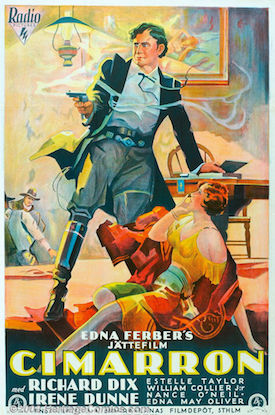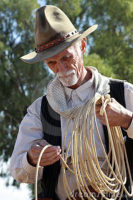 Recently, I picked up a book at one of the local libraries called Killers of the Flower Moon—The Osage Murders and the Birth of the FBI, written by a David Grann. Mr. Grann is a staff writer at the New Yorker so there would probably be some things he and I would not agree on politically, but he did write an interesting book about how a group of people in Osage County, Oklahoma killed off several Osage Indians in order to get the headrights to their oil leases and make lots and lots of money from that.
Recently, I picked up a book at one of the local libraries called Killers of the Flower Moon—The Osage Murders and the Birth of the FBI, written by a David Grann. Mr. Grann is a staff writer at the New Yorker so there would probably be some things he and I would not agree on politically, but he did write an interesting book about how a group of people in Osage County, Oklahoma killed off several Osage Indians in order to get the headrights to their oil leases and make lots and lots of money from that.
It interested me because, back in the late 1960s I had briefly lived in Osage County, Oklahoma, which had been the old Osage Indian reservation. It is still listed that way on some maps.
My Dad had sold his home in the East and bought a trailer and we went West, so wherever we set the trailer up at night, that was home, at least for that night. We got as far as central New Mexico, looking for work, of which there was very little. At the same time I was trying to make a little selling my paintings. The art market in New Mexico was pretty competitive and I wasn’t nearly as good as most of those artists around Taos and Santa Fe, so we headed back east from there.
We recrossed the Oklahoma panhandle, part of the area covered by the Dust Bowl in the 1930s, and we checked work possibilities all the way back across Oklahoma. Just about nil! We ended up in the eastern part of Osage County and spent part of the rest of that year there. Had we been able to get any kind of work, we would have stayed. We even checked into employment for the state park service and my Dad and I went down to Oklahoma City to see about that, but no possibilities even there that would do us any good. And while there, we visited the National Cowboy Hall of Fame, which at the time was having a large exhibit of the work of Western artists, and I wanted so see their work; see how they painted some of those things so natural to the Western scene—rocks, cactus, sagebrush, etc.
Oklahoma is an interesting state—all the way from the hill country in the eastern part of the state to the high plains of the Oklahoma panhandle—where the wind never stops blowing, day or night. I remember one place in the panhandle we stopped for something and I asked a man in front of the store there “Is it always this windy here?” To which he replied “Hell no. Sometimes it gets windier.” After having camped two days at Black Mesa State Park and seen the wind blow about 40 mph 24/7, I wasn’t about to disagree with him!
Anyway, Osage County was also an interesting mix, part of it in what they call the Osage Hills and part of it tall grass prairie. They have what they call bluestem grass there, which is really good for cattle.
There used to be several oil boom towns in Osage County, mostly gone now, but there was one we went through several times called Burbank. It wasn’t the most scenic place around and it looked pretty much like a ghost town, almost no sign of life at all and it had been a rip-roaring town in its heyday. Interestingly enough, we went through there in 1971 so I could show folks we were with what a ghost town looked like, and instead we found a town in the process of being revived, much like what we saw in Virginia City, Montana years later. Some ghosts don’t stay dead!
Oklahoma had its share of interesting characters. The second time we were in Bartlesville, Oklahoma, which is in Washington County, right next door to Osage County, we saw an old man with white hair and a handlebar mustache. He just looked interesting and so we asked about him. Come to find out, in his early days, he had been a train robber and had ridden with the Al Spencer gang. Seems he had gotten caught after a robbery and did jail time. The locals in Bartlesville thought he must have had loot from a robbery stashed somewhere because they said he always had money and no one ever heard of him working.
Another interesting character I got to know was an old trick roper named Raymond. He had some sort of back injury that prevented him from doing rodeos anymore, but boy, could he still do tricks with that rope! He lived in the back of a pawn shop in Bartlesville, a pawn shop that, interestingly enough, was willing to display my Western artwork in its front window. I sold a few pictures because of his display, and I found out an interesting fact. When a lot of Oklahomans buy something off you they want to dicker over the price. In the East that almost never happened. You put a price on something and folks either paid it or walked off. In Oklahoma they wanted to dicker over it. If you had a price of $15 on a picture they’d walk around it, stand back for a few minutes and say “I’ll give $7.50 for it. So if you really wanted to sell it, you learned to dicker with them. You also learned, becoming aware of their horsetrading propensities, to ask a little more for a picture than you really expected to get in hope of coming out of the dickering process with something near what you really wanted. All told, this was an interesting experience.
The time finally came, though, with the austere work situation in Oklahoma, we had to go further east in order to find work to be able to survive. Sad as I was to leave Oklahoma, the Lord knew what He had planned for me. Had we stayed there I never would have married my wife. So in the end, the Lord knows what’s best for each of us.
As our kids got old enough to travel, I wanted my wife and kids to see the places in the West I had enjoyed so much in earlier years and so when the kids were younger we went all over the place out there. My wife loved it like I did. We both still do, though we can’t go anymore. The kids didn’t always appreciate some of the places we took them when they were younger. Now they do. They realize they got to a lot of places that not too many tourists get to.
And through it all, Oklahoma still remains one of my favorite spots—a mixture of West and South—with lots of friendly folks. For any interested in travel, I’d definitely recommend it.
May 14, 2018
 ~ The Author ~
~ The Author ~
Al Benson Jr. is the editor and publisher of “The Copperhead Chronicle“, a quarterly newsletter that presents history from a pro-Southern and Christian perspective. He has written for several publications over the years. His articles have appeared in “The National Educator,” “The Free Magnolia,” and the “Southern Patriot.” I addition to that he was the editor of, and wrote for, “The Christian Educator” for several years. In addition to The Copperhead Chronicles, Al also maintains Revised History.
He is currently a member of the Confederate Society of America and the Sons of Confederate Veterans, and has, in the past, been a member of the John Birch Society. He is the co-author, along with Walter D. Kennedy, of the book “Lincoln’s Marxists” and he has written for several Internet sites as well as authoring a series of booklets, with tests, dealing with the War of Northern Aggression, for home school students.
He and his wife now live in northern Louisiana.
Mr. Benson is a highly respected scholar and writer and has graciously allowed Metropolis Café to publish his works. We are proud to have his involvement with this project.
